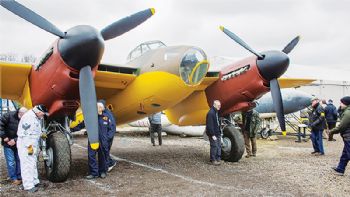
The De Havilland DH.98 Mosquito, which was one of the fastest operational aircraft in the world when it entered service in 1941, was presented with an Engineering Heritage Award by the Institution of Mechanical Engineers (IMechE) (
www.imeche.org), at a ceremony at the de Havilland Aircraft Museum in Hertfordshire on Sunday 1 April, the 100th anniversary of the Royal Air Force.
The fast high-flying Mosquito was, for much of WWII, able to roam almost at will over enemy-occupied territory. Built with wooden components, it was designed for speed and range as a two-seat unarmed light bomber, unarmed reconnaissance aircraft and long-range fighter.
Its performance derived from a combination of “careful packaging”, an aerodynamically clean shape, a high wing loading and high power from two supercharged liquid-cooled V-12 Merlin engines.
The design of the Mosquito evolved over more than 30 variants, and it excelled as a multi-role aircraft. The prototype achieved a maximum speed of 437mph at an altitude of 29,000ft.
Charles Clarke, Associate Member of the IMechE, said: “Confident in their vision for this aircraft, De Havilland persisted with the design and prototyping despite Ministry setbacks; Lord Beaverbrook cancelled the project after Dunkirk, and the first flight took place on 25 November 1940.
"In the end, 7,781 Mosquitos were built — a vindication of de Havilland’s vision.
"The Mosquito’s construction from wood meant that it was easily repaired; it also allowed furniture and piano factories in England, Canada and Australia to build the aircraft.
The absence of armaments meant that it could be kept aerodynamically clean and could carry higher payloads — a philosophy continued by the Canberra and the V- bombers.”
Alistair Hodgson, Curator of the de Havilland Aircraft Museum, said: “I am delighted that the Institution has recognised the Mosquito Prototype with this award.
"The aircraft is a very significant piece of our Aviation Heritage, the more so because the de Havilland Aircraft Museum is located on the site where this aircraft was designed and built in great secrecy.”